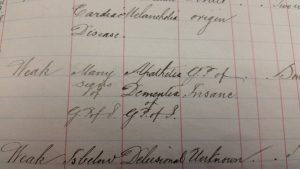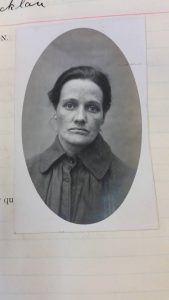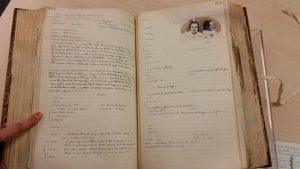Layla Essat is a Masters student in Gender Studies at the University of Stirling. This is the first of a series of articles on her project placement investigating the Stirling District Asylum archive held by the University of Stirling.
Stirling District Lunatic Asylum first opened its doors in 1869. Located in Larbert, many of its patients had been transferred from the large Royal and Private Asylums in Glasgow, Edinburgh and Dundee. Like many institutions of the time, the asylum kept extensive handwritten records, logging and chronicling all under their care. These records for a long time remained stored away and inaccessible but have now found a new home in our very own University archive.
Beginning investigation into the records, I was fairly uncertain of what I was going to find. Undertaking this project in relation to my current Gender Studies Masters at Stirling, my only initial guiding focus was to explore the collection with the aim of discovering the situation of women. With the collection as a whole spanning over a hundred years, it was immediately apparent that a large task lay ahead. In response, I refined my focus to the years 1900 – 1910.

Ploughing my way through hundreds of pages of admissions registers, a familiar phrase kept popping up as “supposed cause of insanity.” What was this G.P of the Insane and why was it wholly prevalent in married women and men? Immediately fascinated and I was intent on learning more about the female patients this affected. With a quick input into google, I soon found the gendered relationship of this illness opening up.
General Paresis otherwise known as General Paralysis of the insane was first coined in the 1830s. As the name suggests, records state that patients at the asylum suffered from broad and vague symptoms, including fatigue, headaches and insomnia. Similarly, family members reported changes in personality, concentration and memory was severely impaired. They all suffered from slurred speech and facial and bodily tremors. Most notably, and highly typical of this disease, was the presence of delusions. This disease was syphilis.

The most socially revealing symptom could be seen in the patient’s eyes and was termed Argyll Robertson pupils. Often termed “prostitute’s pupils”, they were large and unreceptive to changes in light. This discovery proved key. From this I speculated a connection between the use of prostitutes by men and the then inevitable transmission of this illness to their wives. The picture suddenly became much bigger and from here, I begin to question who the real victims in this situation were. In an age where a woman’s marital duty was to provide sex, it would prove highly difficult for these women to protect themselves from the inadvertent dangers of commercial sex. Given that symptoms could take up to 20 years to manifest, innocent wives were likely to pay the price of their husband’s pre-marital sexual encounters as well as any current ones. However, my research revealed that perhaps women caught it first- hand. The women in this asylum all came from some of the poorest sections of society. Marriage was often undertaken out of need to ensure financial security and very less often for love. “Casual Prostitutes” were women who engaged in prostitution as a side line to supplement household income, and often pushed to do so by their husbands.
This condition was otherwise termed The Great Imitator for its habit to share its symptoms with many other illnesses. I believe that this issue was far more widespread than it would first appear and suspect that many others with G.P of the Insane simply went misdiagnosed. Given the sheer number of male sufferers observed in the admissions register, I highly doubt that diagnosis of female patients with this condition to be accurate. I encountered several instances where diagnosis was changed upon death. The majority of women I encountered died in the asylum, and of the very few allowed home, prognosis would dictate that they would have died bedbound soon after.

We will perhaps never know the full plight of these women. However, the bottom lines remains; as long as society maintained the notion of a male right and need for satisfaction of sexual energies, the transmission of venereal diseases amongst prostitutes, innocent wives and their philandering husbands would continue. Bluntly, male demand directly facilitated female harm.
Layla Essat, May 2016